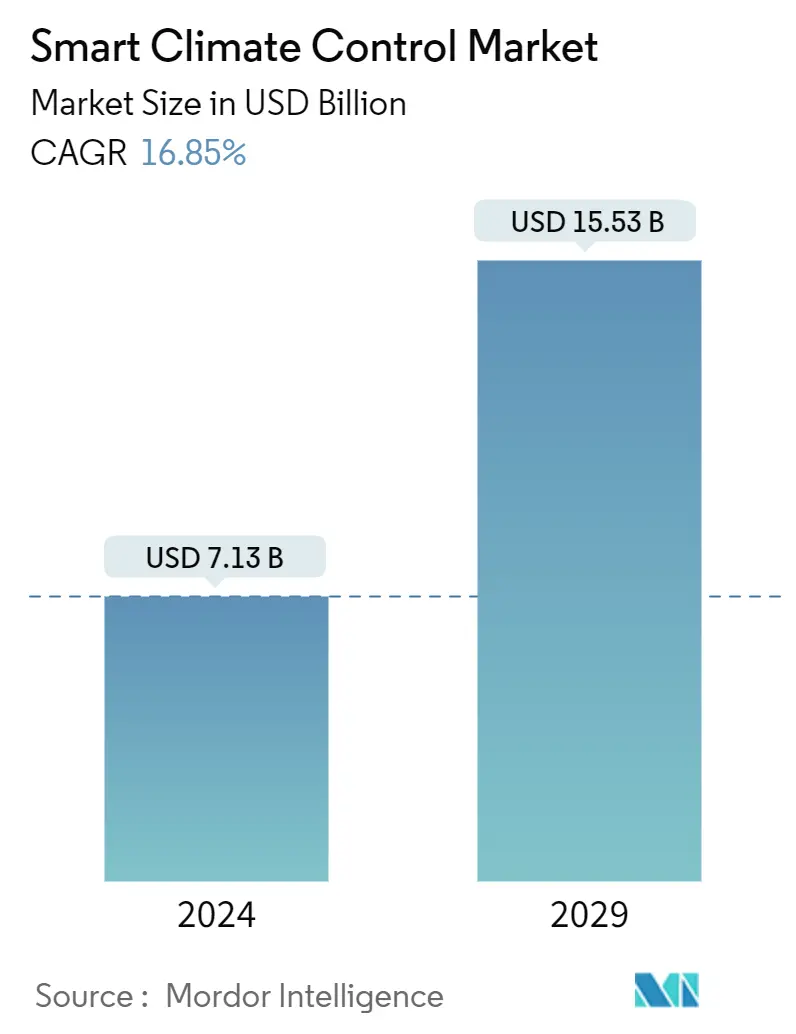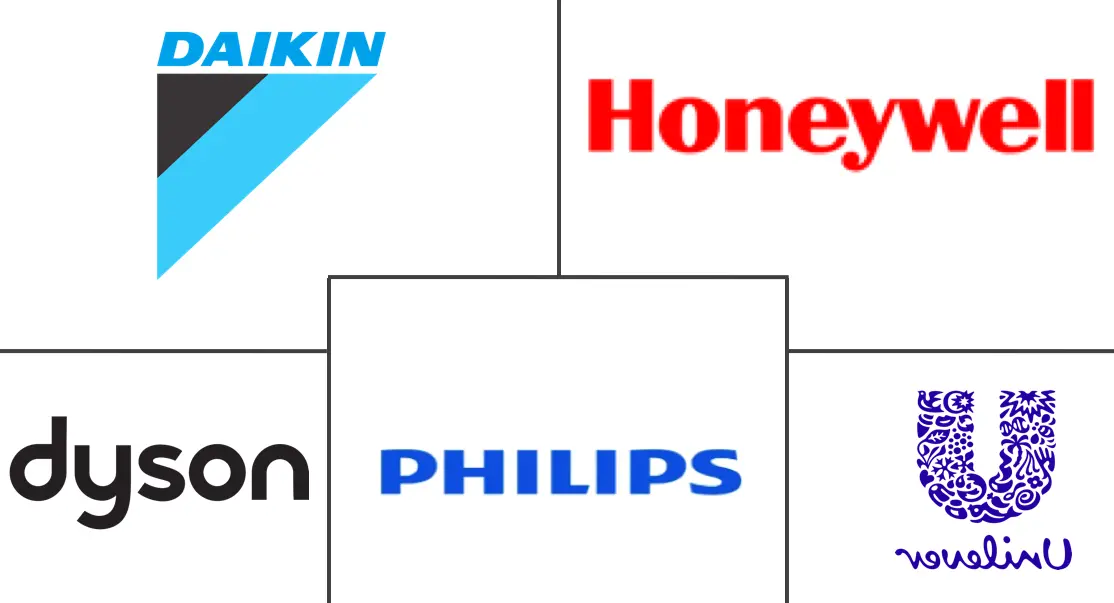
| Study Period | 2019 - 2029 |
| Market Size (2024) | USD 7.13 Billion |
| Market Size (2029) | USD 15.53 Billion |
| CAGR (2024 - 2029) | 16.85 % |
| Fastest Growing Market | Asia Pacific |
| Largest Market | North America |
| Market Concentration | High |
Major Players
*Disclaimer: Major Players sorted in no particular order |
Smart Climate Control Market Analysis
The Smart Climate Control Market size is estimated at USD 7.13 billion in 2024, and is expected to reach USD 15.53 billion by 2029, growing at a CAGR of 16.85% during the forecast period (2024-2029).
The increasing demand for energy-efficient and eco-friendly solutions in residential and commercial buildings has led to the adoption of smart climate control systems.
- The proliferation of the Internet of Things (IoT) technology has made installing smart climate control systems in homes and buildings more affordable. With the help of sensors, smart thermostats, and connected devices, these systems can collect data and adjust settings based on weather and user preferences.
- In recent years, the consumer propensity toward adopting energy-efficient solutions, safety equipment, and building healthy homes has increased significantly across the world, due to which homeowners are increasingly leaning toward adopting health and safety equipment as part of their homes and air purifiers, thermostats, and smart sensors are increasingly becoming the focus.
- The demand for smart and connected air purifiers has gained traction in recent years. There is demand for such devices where the amount of air filtered and other stats visible on the smartphones enable users to have more control and offer alerts when the filters are to be changed.
- In addition, the rise in the need to remove fine airborne particles and germs in automobiles, homes, commercial spaces, and offices drives demand for smart climate control across the globe. However, high maintenance costs and premium installation charges have made smart climate control products expensive, restraining the market's growth.
- COVID-19 positively impacted market growth. Smart air purifiers saw an increase in demand due to the pandemic as people looked for ways to improve indoor air quality and reduce the risk of airborne transmission of the virus. At the same time, smart thermostats and sensors also positively supported market growth as people adopted these products to minimize energy costs and monitor indoor air quality. In this way, the pandemic increased awareness of the importance of indoor air quality and comfort, leading to increased demand for smart air purifiers, smart thermostats, and smart sensors.
Smart Climate Control Industry Segmentation
Smart climate control offers hassle-free control and climate monitoring with connected automation by the user's mobile and internet connectivity that helps to boost the energy efficiency of the user's residence.
The Smart Climate Control Market is segmented by product type (air purifier, smart thermostat, smart sensors) and Geography (North America, Europe, Asia Pacific, Rest of the World). The Air Purifiers Market is segmented by filtration technology (high-efficiency particulate air and other technologies), by type (standalone and induct), and by feature (smart and non-smart). The market sizes and forecasts are provided in terms of value (USD) for all the above segments.
| High-efficiency Particulate Air (HEPA |
| Other Technologies (Electrostatic Precipitators (ESPs), Ionizers, and Ozone Generators) |
| Standalone |
| Non-smart |
Smart Climate Control Market Size Summary
The smart climate control market is experiencing significant growth, driven by the increasing demand for energy-efficient and eco-friendly solutions in both residential and commercial sectors. The proliferation of Internet of Things (IoT) technology has made these systems more accessible and affordable, allowing for the integration of sensors, smart thermostats, and connected devices that adjust settings based on real-time data. This trend is further fueled by a growing consumer preference for health and safety equipment, such as air purifiers and smart sensors, which are becoming essential in maintaining indoor air quality and comfort. The COVID-19 pandemic has also played a role in boosting market demand, as individuals sought to improve air quality and reduce virus transmission risks, thereby raising awareness of the importance of smart climate control systems.
The market is characterized by the presence of major players like Daikin Industries Ltd, Honeywell International Inc., Unilever PLC, and Dyson Ltd, who offer a range of climate control solutions globally. Despite the high entry barriers due to capital expenditure and regulatory requirements, these companies continue to innovate, introducing advanced products like smart air purifiers and thermostats with enhanced features. The demand for such products is particularly strong in regions with high air pollution levels, such as South Asia, where deteriorating air quality has led to increased sales of air purifiers. As consumer spending on home appliances rises, driven by urbanization and higher disposable incomes, smart climate control systems are becoming a preferred choice for those seeking convenience, energy efficiency, and environmental sustainability.
Smart Climate Control Market Size - Table of Contents
1. MARKET DYNAMICS
-
1.1 Market Drivers
- 1.1.1 Increasing Health Problems Associated with Air Pollution
- 1.1.2 Growing Household Spending
-
1.2 Market Restraints
- 1.2.1 High Adoption and Maintenance Costs
2. MARKET SEGMENTATION
-
2.1 By Product Type
- 2.1.1 Air Purifier
- 2.1.2 Smart Thermostat
- 2.1.3 Smart Sensors (Smoke and Air Quality)
-
2.2 By Geography
- 2.2.1 North America
- 2.2.1.1 United States
- 2.2.1.2 Canada
- 2.2.2 Europe
- 2.2.2.1 Germany
- 2.2.2.2 United Kingdom
- 2.2.2.3 France
- 2.2.2.4 Spain
- 2.2.2.5 Rest of Europe
- 2.2.3 Asia-Pacific
- 2.2.3.1 China
- 2.2.3.2 Japan
- 2.2.3.3 Rest of Asia-Pacific
- 2.2.4 Rest of the World
3. AIR PURIFIERS MARKET SEGMENTATION
-
3.1 By Filtration Technology
- 3.1.1 High-efficiency Particulate Air (HEPA
- 3.1.2 Other Technologies (Electrostatic Precipitators (ESPs), Ionizers, and Ozone Generators)
-
3.2 By Type
- 3.2.1 Standalone
- 3.2.2 Non-smart
Smart Climate Control Market Research FAQs
How big is the Smart Climate Control Market?
The Smart Climate Control Market size is expected to reach USD 8.33 billion in 2025 and grow at a CAGR of 16.85% to reach USD 18.15 billion by 2030.
What is the current Smart Climate Control Market size?
In 2025, the Smart Climate Control Market size is expected to reach USD 8.33 billion.


